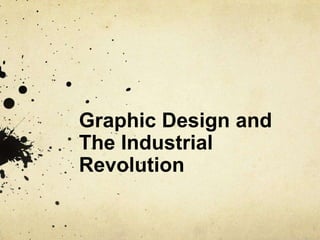
Graphic design and the industrial revolution new
- 1. Graphic Design and The Industrial Revolution
- 3. England 1760 – 1840 Extreme social/econom ic change. Steam engine perfected = greater productivity. Technological improvement - mass production - increased availability & lower costs.
- 4. • Graphic communications – more important & accessible. • Photography was invented. • Fast expansion of jobbing printers, advertising & posters. • Advancements in font types & sizes – problems for printing. • 1800 – Charles Stanhope invented the printing press which reduced required manual force and could print a sheet double the conventional size. • John Walter II & Friedrich Koening created 2 double-cylinder steam powered press – used to print The Times. • 1815 – William Cowper & Ambrose Applegath developed the 4 cylinder steam-powdered press.
- 5. Mechanization of Typography • Mid 19th century – presses could mass produce up to 25000 copies per hour – but each letter had to be set by hand = limited newspapers. • Advancements in technology – machine set typography printed on machine made paper. The first steam-powered cylinder press, 1814. Koenig’s invention caused the speed of printing to skyrocket, while its price dropped considerably.
- 6. Photography • Joseph Niepce – Frenchman who produced the 1st photographic image. • He coated a pewter sheet with light-sensitive asphalt which hardens when exposed to light. • He then contact printed a drawing, which had been oiled to make it transparent, to the pewter, washed it with lavender oil and then etched it with acid. This was called „sun engraving.‟
- 7. • After a long process of experimenting and collaboration with Louis Jacques Daguerre – perfected process in 1839. • About the same time in England – William Henry Fox Talbot produced a process that formed the basis for photography. • In the late 1840s Talbot developed a new process called “calotype” – increased light sensitivity of paper. • In 1888 – American dry-plate manufacturer, George Eastman introduced the Kodak camera. • Photography was used as a research tool. • 1880-1890 – photomechanical reproduction replaced skilled craftsmen, process reduced printing time. • Moving images became a possibility.
- 8. Photography as Reportage • 1st occurrence of reportage photography – American Civil War. • Mathew Brady – photographed the war.
- 9. Victorian Era 1849 – Queen Victoria’s husband conceived the idea of a grand exhibition with hundreds of exhibitors from all industrial nations – known as the Crystal Palace Exhibition.
- 10. Chromolithography • Lithography = a method of printing using an etching stone on a completely smooth surface. • Chromolithography = method for making colour prints. • By 1860 its popularity had grown immensely. • Without traditions & constraints of the letter press, designers could invent any letter form and utilize an unlimited palette of vibrant colours that they could
- 11. • Circuses and carnivals first to use these new methods for their posters. • Chromolithography was then moved onto labels & packages. • By 1897, chromolithography became obsolete.
- 12. Battle of the Signboards • Mid 19th century – letterpress poster & broadsheet were challenged by more visual & pictorial posters. • Lithography allowed for a more illustrative approach to public communication. • Large woodblocks were printed in sections – then assembled by poster hangers. • In France – letterpresses and lithographers combined their skills to create colourful lithographic illustrations – pasted onto large
- 13. Images for Children • Pre-Victorian Era – children were treated like adults. • Victorians began to treat them more tenderly with the development of toybooks – colourful picture books for preschool children. • Walter Crane (1845-1915) • Randolph Caldecott (1846-1886) • Kate Greenaway (1846-1901)
- 15. Rise of American Editorial & Advertising Design • James & John Harper launched a printing firm in New York (1817.) • The firm opened the era of the pictorial magazine with Harper’s New Monthly Magazine.
- 16. Victorian Typography • In the Victorian Era, the taste for ornate elaboration was a major influence. • Outlandish and fantasy lettering was very popular – many trademarks in the era reflect the Victorian love of ornamental complexity. • Even today, Victorian design conventions are still found, particularly in commercial promotion.
- 18. The End.